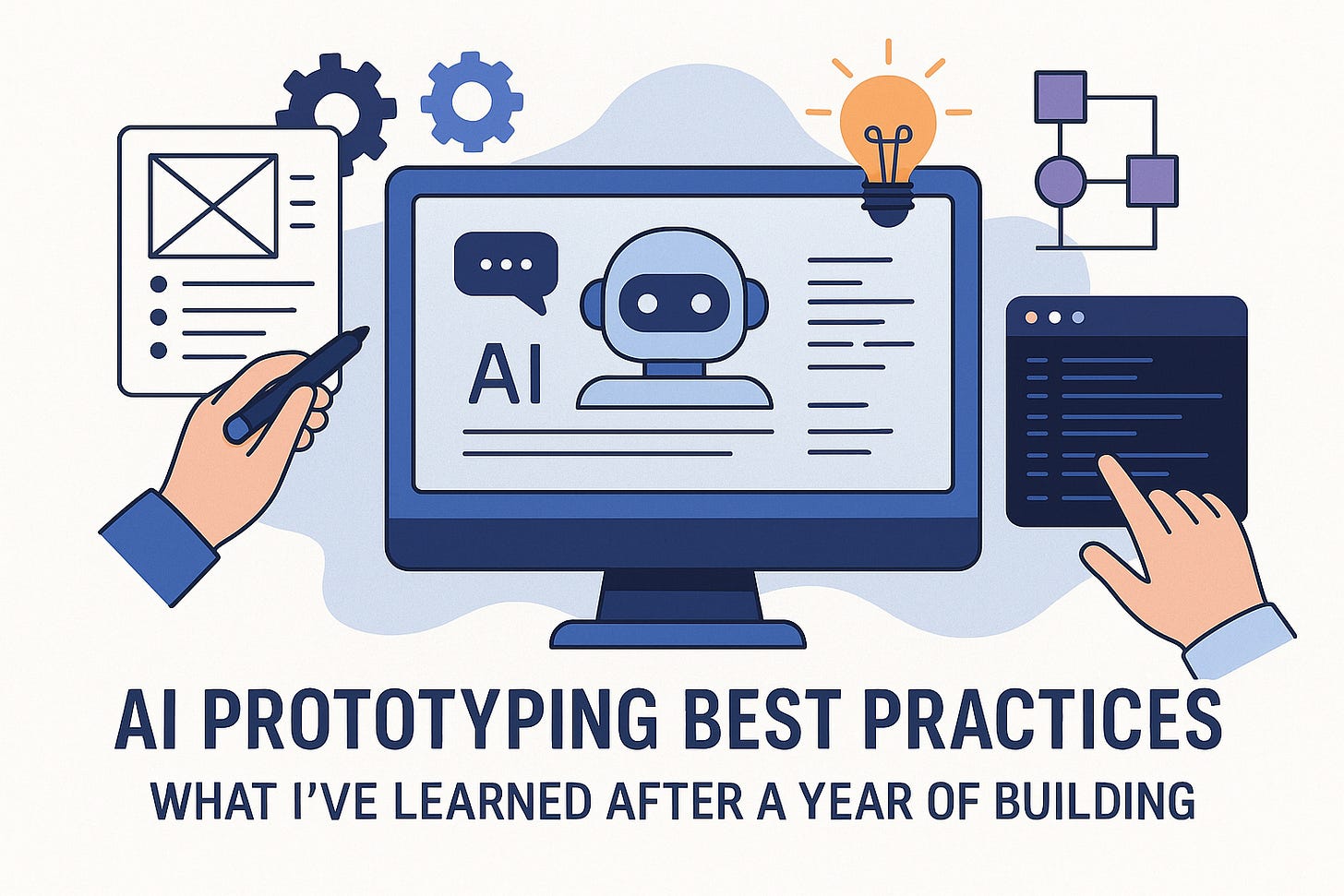AI Prototyping Best Practices: What I've Learned After a Year of Building
Practical lessons from a year of AI-assisted building, from planning to the last mile
After a solid year of working with AI development tools almost daily, building everything from simple prototypes to production apps serving hundreds of users, I’ve identified some universal best practices that apply across all platforms. Whether you’re a seasoned product manager or a founder exploring vibe coding for the first time, these insights can save you from common pitfalls and accelerate your development process.
Planning still matters (even more than you think)
Here’s something that might surprise you: the more context you give AI tools, the better your results. Yes, you can throw a simple idea at ChatGPT or Claude and get something functional, but I’ve learned this approach often creates problems you don’t see until later.
Think of it like building on shaky foundations. Your UI might look perfect, but underneath the hood, there are fundamental architectural issues waiting to surface. By the time you discover them, you’re already deep into development, and fixing them requires significant rework.
I’m not saying you need a full product requirements document (though it wouldn’t hurt), but taking time upfront to plan and provide detailed context makes a meaningful difference. This isn’t unique to AI development, of course, but the principle becomes even more critical when you’re relying on tools that thrive on rich, detailed input.
The more context you give AI tools, the better your results
The great model convergence
Here’s something interesting I’ve observed: frontier models are producing remarkably similar outcomes. Whether you’re using ChatGPT, Claude, or other leading models, the end results tend to converge despite all the benchmark wars and accuracy comparisons.
Don’t get me wrong, those benchmarks matter for people in the industry, but for builders just trying to turn ideas into reality? The model choice matters less than you’d expect. What’s more impressive is how these models are getting better at error reduction, writing cleaner code with less tech debt from the start.
This convergence means you can focus less on which AI tool to use and more on how you’re using them.
Infrastructure is the new battleground
AI development tools have realized they can’t just be about writing code anymore. As vibe coding becomes mainstream, people need the full stack: servers, databases, storage, all connected and working together.
The platforms that are winning this race are the ones that remove complexity while maintaining flexibility. They’re enabling non-technical people to build what previously required teams of engineers and infrastructure specialists. This is a massive shift in who can participate in software development.
But here’s the thing, this infrastructure piece can’t be an afterthought. It needs to be baked into the development process from day one, seamlessly integrated so builders don’t have to think about it until they need to.
The last 20% problem
I’ve noticed a consistent pattern: most people can handle the first 80% of development remarkably well. They can build prototypes with AI, create functional apps, even get close to production-ready products. But that final 20% often becomes a significant hurdle.
Sometimes it’s technical (security considerations, performance optimization), but often it’s psychological. There’s uncertainty about publishing to production, especially for business applications where the stakes feel higher. This hesitation is understandable and often justified, but it represents a clear opportunity.
For platforms building these tools, solving the “last mile” problem could be a major differentiator. For service providers (technical and non-technical alike), there’s a growing market of builders who need help bridging that final gap.
The executive prototype revolution
Not everyone will embrace vibe coding initially. I remember similar resistance to social media in its early days. But I’m already seeing something fascinating happen in forward-thinking companies.
Picture this: a CEO has an idea over the weekend. Instead of scheduling meetings and trying to explain it to their technical team, they jump into an internal tool, describe their concept in plain language, and create a working prototype. That prototype gets automatically routed to a product manager, analyzed against customer data, and scored for potential impact.
This removes a massive communication barrier. Subject matter experts can finally create solutions for the real problems they understand intimately. No more lost-in-translation moments between business vision and technical execution.
This shift creates both challenges and opportunities for existing solution providers. Some may see their products replicated internally, but smart companies will find ways to offer complementary services, integrations, and specialized expertise around these internal tools.
What this means for you
Whether you’re a product manager exploring AI tools or a founder considering vibe coding for your next project, these patterns suggest we’re still in the early stages of a fundamental shift. The barriers between having an idea and building a solution continue to collapse.
The key is approaching this evolution strategically. Plan more than you think you need to. Don’t get caught up in model wars. Focus on platforms that solve the infrastructure puzzle elegantly. Prepare for that last 20% challenge. And if you’re in a leadership position, consider how empowering your team with these tools might unlock ideas that would otherwise never see the light of day.
What’s your experience been with AI-assisted development? Are you seeing similar patterns in your organization, or have you encountered different challenges entirely?
If you found these insights valuable, I’d love to hear about your own AI development experiences. Reply and let me know what best practices you’ve discovered or what challenges you’re still working through.


